These two methods show how to cook jasmine rice perfectly every time, so there is no guesswork involved! If you opt for the absorption method, the water-to-rice ratio is essential, and you will need 1.25 cups of water for every cup of rice—this rice requires less water than other types. Below, I share my best tips for preparing perfectly cooked rice every time, whether you want to use it for fried rice or as a side dish.

Between my Asian husband and his bags of basmati rice and my different boxes of Arborio, Ribe, and Carnaroli [and a few more!], you won't be shocked to hear we use many more types of rice in our house on a regular basis.
Whether we use them to make burritos, suppli', or stuffed vegetables, one thing we always agree on is that the rice must be perfectly cooked.
Jasmine rice is one of my two options when making fried rice, the other one being basmati, of course, and I have perfected it.
Below, I share two foolproof methods for cooking jasmine rice on the stove: absorption or boiling. The grains will be tender, the floral smell delicate, and the rice sticky, as you'd expect!
Note that this recipe is for white jasmine rice, brown rice requires different cooking times and proportions!
Jump to:
- Jasmine Rice Overview
- 💎 Why This Recipe Works
- 🛒 Ingredients
- ♻️ Substitutions and Variations
- 👩🏻🍳 Absorption Method: How To Cook Jasmine Rice (Step-By-Step)
- 👩🏻🍳 Boiling Method: How To Cook Jasmine Rice (Step-By-Step)
- 🙋♀️ People Also Ask [FAQs]
- 💡 Expert Tips and Tricks
- 🍴 You May Be Interested to Learn
- 🍽️ Recipe
Jasmine Rice Overview
What is Jasmine rice? Although it carries the name of the flower, the two have no connection! Jasmine rice is called this not because of its aroma, as commonly thought, but because of the color of the grain, which is as white as the jasmine flower.
It is a long-grain rice variety mainly grown in Thailand but very popular all over South East Asia. In addition to its wonderfully delicate smell, this white rice has a soft texture and is slightly sticky when cooked.
Jasmine rice is used in steamed dishes as a side, to make fried rice [like yummy steak fried rice and crispy chicken fried rice!], but also in salads, soups, and desserts.
This rice absorbs flavors very well, and because of this, its versatility is paired with curry sauces, delicious rice pudding, or coconut rice cakes - enhancing both sweet and savory dishes.
💎 Why This Recipe Works
- You will only need rice, water, and salt. However, to make your dishes your own, I will share a few suggestions for adding personal twists. As the rice absorbs water when cooking, it's important to season it for the best results.
- The absorption method requires exact volume measurements for the perfect end result. You will need 1 ¼ cups of water for each cup of rice. Jasmine rice is softer than basmati or bomba rice, so it requires less water for perfect fluffy rice!
- These methods offer the best and easiest way of cooking rice on the stovetop. No fancy equipment or rice cooker is needed. One pan with a tight-fitting lid is all you need—and no soaking, either!
- Always rinse rice thoroughly! I know pre-packed rice comes fully cleaned; however, some extra starch and rice dust remain, which can make the rice a little too gummy and sticky. Thoroughly rinse it, especially if you are following the absorption method.
- If you are boiling and draining the rice, you can skip the rinsing part, but remember to add a tablespoon of lemon juice to the water. This will help the starch separate from the grains!
🛒 Ingredients

- Jasmine Rice: To select the best rice, prioritize fragrance and origin. Look for a subtle, floral aroma and the rice package labeled as originating from Thailand, where the finest jasmine rice is grown. Opt for grains that appear long and slightly translucent to ensure freshness and quality.
Be sure to check out the recipe card for all the ingredients and instructions you'll need to make this dish. Don't miss out on any of the details!
♻️ Substitutions and Variations
- Broth Instead of Water: As I suggested when cooking basmati rice, you can use vegetable, beef, or chicken broth instead of water. However, adjust the amount of salt you add.
- Use Whole Spices: Add cardamom pods, cloves, cinnamon sticks, or star anise while cooking the rice following the absorption method. The spices will float to the top, and they will be easy to remove before fluffing the rice. These whole spices complement the natural fragrance of jasmine rice without overwhelming it, adding depth and warmth to your dishes.
- Butter or Oil: Add a tablespoon of either to the cold water for extra flavor!
👩🏻🍳 Absorption Method: How To Cook Jasmine Rice (Step-By-Step)


- Rinse jasmine rice until the water runs clear. You can use a bowl to rinse it three to four times or do it under running water in a fine mesh strainer. [Picture 1]
- Add rinsed rice, cold water, and salt to a saucepan and mix well. [Picture 2]


- Put the pan on high heat and bring the water to a boil.
- As soon as the water reaches a rolling boil, cover the pan with the lid and reduce heat to low so that the water gently simmers.
- Allow the jasmine rice to cook for 12 minutes.
- After 12 minutes, switch off the heat, and let the rice rest with the lid on for 10 minutes.
- After the rice has rested, remove the lid. [Picture 3] Fluff the rice up using a rice paddle, wooden spoon or fork. [Picture 4]
- Serve jasmine rice with your desired curry or stir fried vegetables and proteins, or allow it to cool down completely to prepare fried rice!
👩🏻🍳 Boiling Method: How To Cook Jasmine Rice (Step-By-Step)


- Rinse the rice in a bowl or under running water. [Picture 1] The water doesn't need to be completely clear for this method, as it will be drained away.
- Heat up a large saucepan of water until it comes to a rolling boil, then add salt. [Picture 2]
- OPTIONAL: Add a tablespoon of lemon juice to the boiling water. The mild acidity of lemon juice slightly alters the pH level of the water, resulting in a more appealing texture and preventing the rice from becoming too sticky." I learned this when reading the book ''On Food and Cooking: The Science and Lore of the Kitchen" by Harold McGee. The book goes over many interesting science facts relating to food, including the effects of pH on cooking processes.


- Add the rice to the salted boiling water and cook it for 10-12 minutes, depending on your preference. [Picture 3]
- Once ready, drain the rice and allow it to rest in the fine mesh strainer or colander for about 5 minutes.
- Once rested, move it to a bowl and fluff it with a fork. The perfect Jasmine rice is ready to be served! [Picture 4]
🙋♀️ People Also Ask [FAQs]
To obtain the perfect jasmine rice the rice-to-water ratio is 1.25 to 1, so you will need 1 ¼ cups of water for each cup of dry rice.
Yes, eliminating excess starch and rice powder really helps create the perfect rice, although it depends on the cooking method. If cooking by absorption, the rice will need to be thoroughly rinsed for a fluffy result. However, if you are boiling the rice, and this step is skipped, the difference is not as noticeable, as once the rice finishes cooking, the water is drained away.
No, it is not. Jasmine rice is softer than others, so soaking it may make it mushy.
Store Jasmine rice in an airtight container in the fridge for up to three days, or in the freezer for up to two months. The rice can be thawed overnight in the fridge, or heated up while still frozen in the microwave.

💡 Expert Tips and Tricks
- Sticky Rice: When it cools down, jasmine rice is very sticky and hard to separate. Don't worry! As soon as you start warming it up, the grains become much easier to handle.
- Proportions: Always measure your water and rice by volume when cooking jasmine rice!
- Al Dente: My absorption method shares directions for grains of rice cooked al dente. If you prefer yours softer, add one or two tablespoons of water and cook for a couple more minutes—adjust the time and water to your preference.
- Saucepan: Choose a heavy-bottom saucepan, as it will help distribute the heat more evenly, making it easier to cook rice perfectly. Choose its size based on how much rice you are cooking; for four portions, I chose a medium saucepan.
🍴 You May Be Interested to Learn
Have you given this recipe a try? We'd love to hear your thoughts! Please leave us a ⭐ review below, and don't forget to tag us @theperfectrice on Instagram and Pinterest. Your feedback means the world to us, and we really appreciate it. For more recipes, follow us on Pinterest, Facebook, YouTube, and Instagram. Thank you! 🙏
🍽️ Recipe
How To Cook Jasmine Rice [On Stove, 2 Ways]
Ingredients
- 1 cup Jasmine Rice
- 1 ½ cups Cold Water
- Salt To Season
Instructions
Absorption Method
- Rinse the jasmine rice until the water runs clear. You can either use a bowl to rinse it three to four times, or do it under running water in a fine mesh strainer. Rinsing rice is essential, as the extra rice powder and excess starch are eliminated.
- Select a heavy bottomed pan with a tight fitting lid. Add rinsed rice, cold water, and salt to it. Mix well.
- Put the pan without the lid on the largest hob, on a high heat and bring the water to a boil.
- As soon as the water reaches a rolling boil, cover the pan with the lid and reduce heat to low, so that the water gently simmers. If necessary, move the pan to a smaller hob.
- Allow the jasmine rice to cook for 12 minutes.
- After 12 minutes, switch off the heat, and let the rice rest with the lid on for 10 minutes. The rice will absorb the remaining water, while the heat will also dry up the excess moisture, creating perfect sticky rice.
- After the rice has rested, remove the lid. Fluff the rice up using a rice paddle, wooden spoon or fork.
- Serve jasmine rice with your desired curry or stir fried vegetables and proteins, or allow it to cool down completely to prepare fried rice!
Boiling Method
- This is an easy, everyday method to cook jasmine rice, as it is simple an needs no exact measurements. Rinse the rice in a bowl or under running water; the water doesn't need to be completely clear for this method, as it will be drained away.
- Heat up a large saucepan of water until it comes to a rolling boil, then add salt.
- OPTIONAL: Add a tablespoon of lemon juice to the boiling water. The mild acidity of lemon juice slightly alters the pH level of the water, resulting in a more appealing texture and preventing the rice from becoming too sticky."
- Add the rice to the salted boiling water and cook it for 10-12 minutes. Cooking times depend on your personal preference and what dish you will use the rice for.
- Once ready, drain the rice and allow it to rest in the fine mesh strainer or colander for about 5 minutes. This will eliminate all the excess water from the rice.
- Once rested, move it to a bowl and fluff it with a fork. The perfect Jasmine rice is ready to be served!
Notes
- You will need 1 ¼ cups of water for each cup of rice.
- Store Jasmine rice in an airtight container in the fridge for up to three days, or in the freezer for up to two months. The rice can be thawed overnight in the fridge, or heated up while still frozen in the microwave.

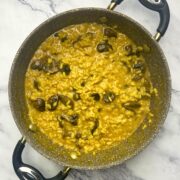
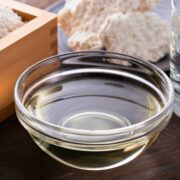

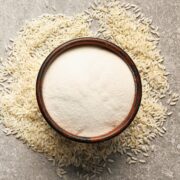
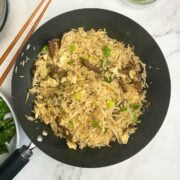
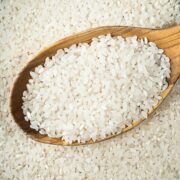
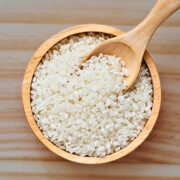
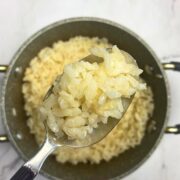
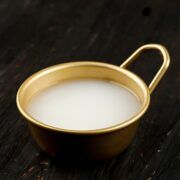
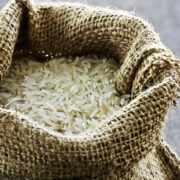
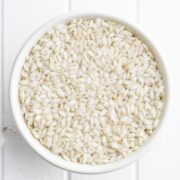

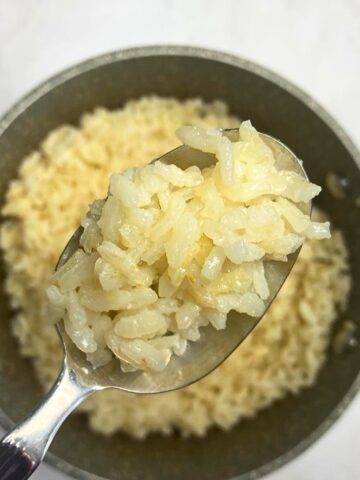

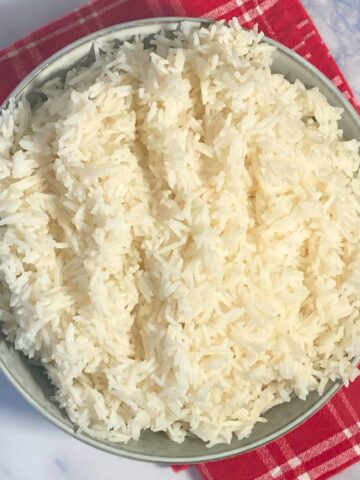
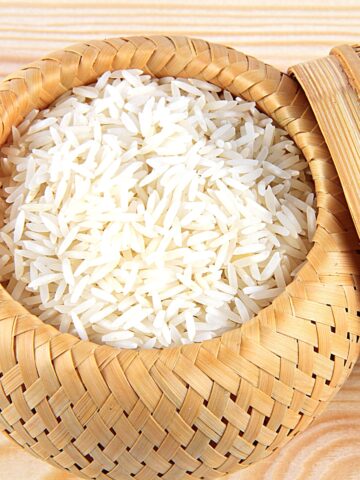


Leave a Comment